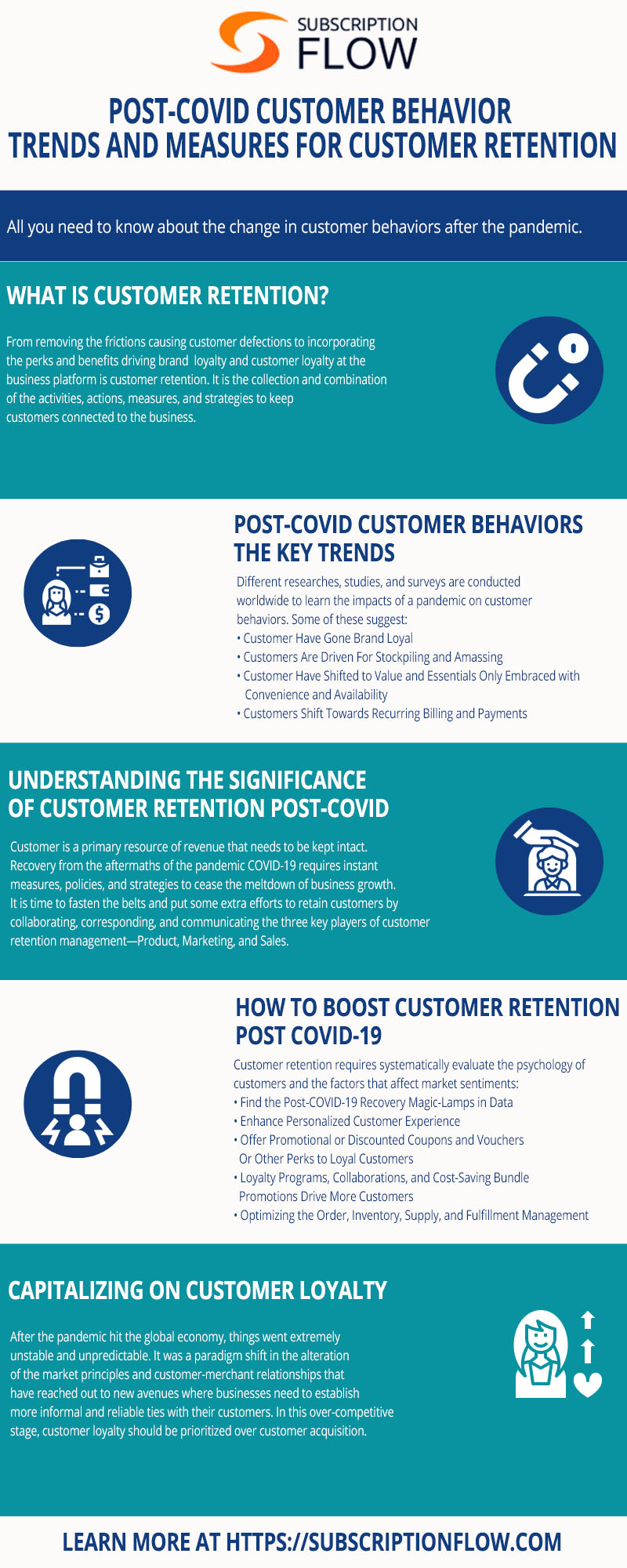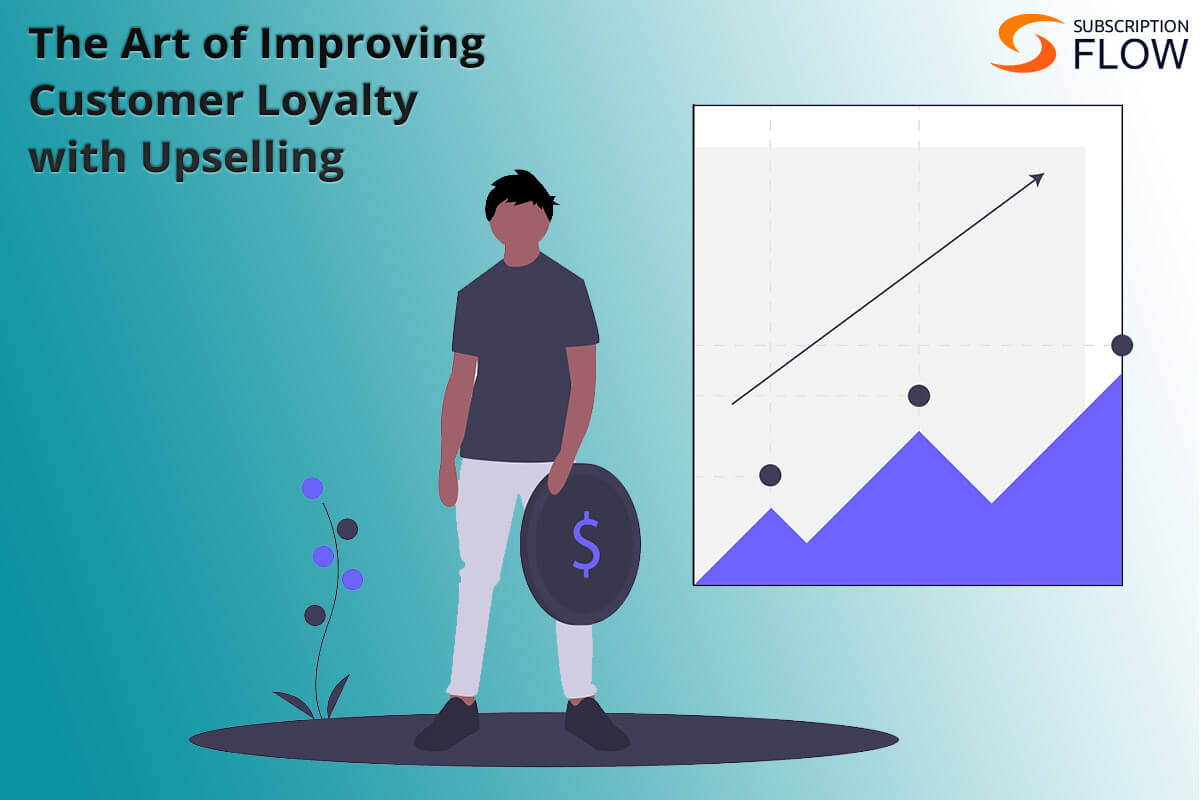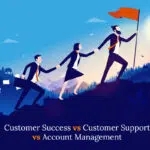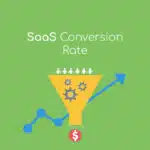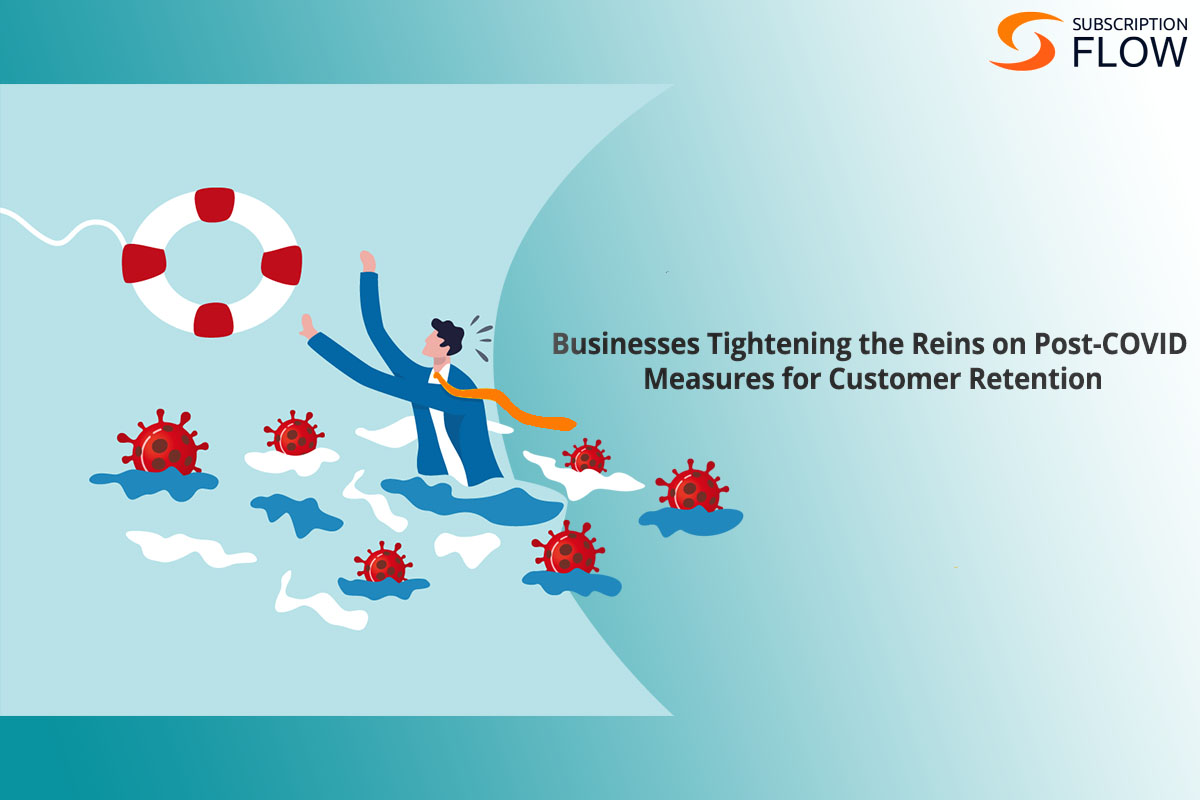
Businesses Tightening the Reins on Post-COVID Measures for Customer Retention
The coronavirus pandemic wreaked customer earning and spending behaviors. Layoffs, pay cuts, unit shutdowns, instability of demand and supply, economic downfall, mounting pressures on the market, and many more—all these unpredictable and unstable factors injected anxiety, hesitation, and terror of uncertainty in customers and they restrict their funds into their accounts only.
This article demonstrates the significance of customer retention while discussing the measures that need to be taken in the line with the Post-COVID trends of customer behaviors.
Also Read: Recurring Billing Amid COVID-19 Is Changing the Ways We Earn and We Pay…
Understanding Customer Retention and Its Significance
From removing the frictions causing customer defections to incorporating the perks and benefits driving brand loyalty and customer loyalty at the business platform is customer retention. It is the collection and combination of the activities, actions, measures, and strategies to keep customers connected to the business.
Customer retention plays an important role in the growth of a company and the streaming of revenue, flooded with profits. It enables businesses to power the value of their customer base by providing them an excellent customer experience.
Customer retention also increases customer lifecycle while reducing churn. In the subscription, SaaS, rentals, and other recurring billing businesses, customer retention is the most important factor to increase the probabilities of recurring revenue growth.
On the other side, customer retention also shows customer’s trust and satisfaction with the product or service. Customer is a primary resource of revenue that needs to be kept intact, from the beginning, so that they, not only, buy a product once, would remain loyal to the brand and use product time and again.
What Drives Customer Retention?
Customer retention management is not an Adhoc measure, in fact, it begins long before devising the strategies for customer acquisition when a foundation is laid for the development of a product or service.
The founder and growth strategist at Donaldson Capital, Drew Donaldson, said the three key business processes that play a vital role in the management of customer retention are product development, marketing, and sales.
These three groups collaborate, coordinate, and communicate to formulate the strategies, policies, plans, and approaches to optimize customer engagement for customer retention.
A product came into existence and developed as a problem to a solution for the consumer. The customer is approached by using different marketing tactics and strategies to tap them into a source of revenue by the sales department. The marketing and sales groups suggest further changes, alterations, or modifications to the product development department. This collaboration removes frictions from the product related to quality, cost, market, market approach, and together, they strive to influence the customer behavior to make a purchase again, and again.
How COVID-19 Impacts Customer Retention—The Key Customer Behavior Trends
Different researches and surveys are conducted worldwide to learn the impacts of a pandemic on customer behaviors. Some of the key COVID-19 changes in customer behaviors suggested by these studies are:
-
Customer Are Gone Brand Loyal
Yotpo, an e-commerce marketing platform surveyed to learn the customer preferences of the product and brand during COVID-19. The survey suggests that customers have become more brand loyal than the previous year.
It shows how the customer is afraid to try or test a new product that may result in a loss of money. If they are satisfied with any of the products, they prefer to use them, even, at higher prices. On the other hand, the dissatisfaction from a product or service, if these are available at cheaper prices even, increases their anxiety.
Brand loyalty, in other ways, also impacts competition in the market as well. The trend suggests that new startups have to take some robust marketing and sales measures to acquire customers with a brilliant product that can retain them, too.
-
Customers Are Driven For Stockpiling and Amassing
The eCommerce giant, Amazon, reported the end of stocks and, even, notified their customers. As soon as the lockdowns were imposed worldwide from the beginning of 2020, a fear of unavailability of the medicine, household essentials, disinfectants, food and beverage items, and other commodities along with the surge in pricing had encompassed people everywhere in the world.
They had dragged themselves to stockpiling which created an uncertain imbalance in the demand and supply, also provided an opportunity for the fraudulent elements to induce artificial shortage. It eventually, skyrocketed the pricing.
Stockpiling and amassing means a shortage of demand, hence a clear shortage in supply. It caused a reduction in product development and reliance on previous profits while having the same operational costs. The gap in supply and demand can provide competitors the opportunities to damage the brand loyalty and later fulfill the demand with their supply.
-
Customer Have Shifted to Value and Essentials Only Embraced with Convenience and Availability
According to McKinsey, consumers lost their affinity to spend on discretionary items in most countries. Their spending habits are more focused on value and essentials, only.
The studies suggest that value remains the core reason that drives customer sentiment in the market. They are brand loyal until they found some products cheaper than their preferred brand. In addition to value, the convenience to get these items, and their availability ratio in the market, are two other factors that are impacting the customers’ purchasing decisions and behaviors.
This indicates that customers are desperately persisting for options that can save their money. The lesser the product or services are cost, the more customers are drawn to the businesses.
-
Customers Shift Towards Recurring Billing and Payments
A report, Global Subscription E-commerce Market: Size and Forecasts with Impact Analysis of COVID-19 (2020-2024), suggest an increase in the market sizing and growth. The report provides an analysis of the global subscription e-commerce market in terms of value and segments.
The report projected further growth in the global subscription economy for the forecast period of 2020-2024. The reports suggest the following growth-enhancing facts that would drive the growth in recurring billing and subscription businesses. These are:
- The growing use of subscriptions among millennials
- The rising popularity of online streaming services
- Increasing internet penetration
- Low cost of subscription boxes
- Convenience to access a product or services
- Low-maintenance of digital goods and services
Why Should the Post-COVID Revenue Growth Strategies be Focused on Customer Retention?
Studies suggest severe revenue losses across the industries that include manufacturing, banking and finance, telecommunications, and others.
Recovery from the aftermaths of the pandemic COVID-19 requires some instant measures, policies, and strategies to cease the meltdown of business growth. From retail to tech market to SaaS, businesses everywhere have experienced churn, market shrink, revenue loss, operational costs surge, profit instability, demand and supply disparity, and more.
For the SaaS and subscription-model based industries, customer retention is more important as they survive on recurring revenue. And, recurring revenue requires constant streaming of cash flow through subscriptions, re-subscription, upgrades, re-sells, and cross-sells.
Retaining customers can provide them to have a predictable and stable demand and supply current that can ensure the streaming of the recurring revenue. It is time to fasten the belts and put some extra efforts to retain customers by collaborating, corresponding, and communicating the three key players of customer retention management—Product, Marketing, and Sales.
Marketing and sales alone cannot guarantee customer retention, it is the quality and need of the product in the market that can affect the customer behavior towards continuing the customer engagement and, consequently, the customer retention. Pursuing the customer value and evaluating the customer lifecycle can help to define the objectives of the customer retention post-COVID-19.
Also Read: Combating Churn for a SaaS—Use Content to Attract, Educate, Convert and Retain Customer
Inevitable Measures to Boost Customer Retention Post COVID-19
Customer retention requires systematically evaluate the psychology of customers and the factors that affect the market sentiments and brings changes in the purchasing behaviors of customers.
The usual ways to manage customer retention include:
- Setting customer retention goals
- Pinpointing and dedicating the players and resources
- Evaluating customer expectations
- Identifying the elements that drive trust and credibility
- Using the resources and relationships to influence the market
- Taking a proactive approach to customer support
- Strengthening the inter and intra communications approach
- Fulfilling the customer needs of information and education in relation to product and services
- Driving personalized solutions to customer problems to provide enhanced customer experience
Fine-tuning the guidelines, businesses can focus on the following instant and effective measures for customer retention post-COVID.
Here are the five laser-focused strategies that can help businesses to bring more brand loyalty and lead to boost customer retention:
-
Find the Post-COVID-19 Recovery Resort in Data
Today, data is the most valuable asset that can find solutions to any problem. Organizing the sales, marketing, and customer service and support data would lead to the identification and data-driven documentation of the hard and soft frictions that are affecting the customer purchasing behaviors.
The soft resistances include price surge, misinformation, controversy, competition, market sentiment, and some other factors that can easily be removed by taking the stakeholders and product development units onboard, once identified.
However, hard resistances like the quality of the product or decrease in the need for the product or service in certain circumstances, no information or extremely ingrained controversy, etc. also require long-term campaigning, product alteration, or re-branding, like solutions.
-
Enhance Personalized Customer Experience
Post-COVID-19 has increased the significance of the personal customer experience like never before. Providing customer personal experience can take them out of their fear and uncertainty and drive trust, credibility, reliability towards the product.
Creating a personal customer experience is characterized by factors like convenience of billing, shipping, and payment processing, support, availability of the product or service, the comfort of easy recurring billing or discounted pricing, and providing information and education of the product and services as a solution to a problem.
-
Plan Customer Retention Communication Strategy Based on Effective Content and Inbound Marketing
Creating targeted and personalized content with effective inbound marketing is the best weapon in the arsenal of customer retention management to combat churn, revenue losses, customer loss, and more. SubscriptionFlow now helps businesses in churn reduction to improve their customer base.
Email marketing, social media marketing, and paid ads to market solutions to the problems in the form of product development, price decrease, discounts, engagement offers, and more when channelized with an innovative content development strategy would hit the target, accurately. Providing useful and meaningful content in the form of blog posts, social media posts, reviews, visual content, and others are the best ways to optimize customer engagement through creative content.
-
Offer Promotional or Discounted Coupons and Vouchers Or Other Perks to Loyal Customers
Discounts and other perks, in all circumstances, attract customers, but after the pandemic when the people are preferring conscious-driven shopping, these discounts and promotions power up brand loyalty and can setback competitors.
-
Loyalty Programs, Collaborations, and Cost-Saving Bundle Promotions Drive More Customers
Businesses are finding revenue growth solutions in the form of collaborations and/or mergers with other businesses or offering their own other products and services in bundles. These collaborations and ventures are reducing the demand and supply, operational costs, sales and marketing, and other pressures over revenue growth help them overcome stress and hassles.
-
Optimizing the Order, Inventory, Supply, and Fulfillment Management
Businesses often least bother with the management of order, procurement, inventory, shipping, and delivery management.
Pandemic has favored the online shopping and delivery of the products at the customer’s doorsteps. In the COVID-19 times, the hassles caused due to the mismanagement of the supply chain operations can severely hurt the overall strategy for the management for customer retention.
Optimizing the supply chain eases the burdens on merchandise, retail, and trade businesses.
Capitalizing on Customer Loyalty…
After the pandemic hit the global economy, things went extremely unstable and unpredictable. It was a paradigm shift in the alteration of the market principles and customer-merchant relationships that have reached out to new avenues where businesses need to establish more informal and reliable ties with their customers. In this over-competitive stage, customer loyalty should be prioritized over customer acquisition.
